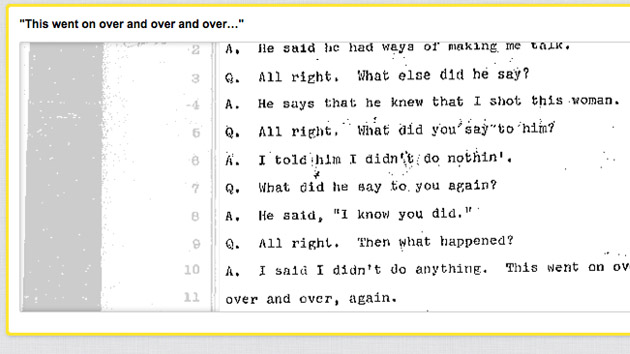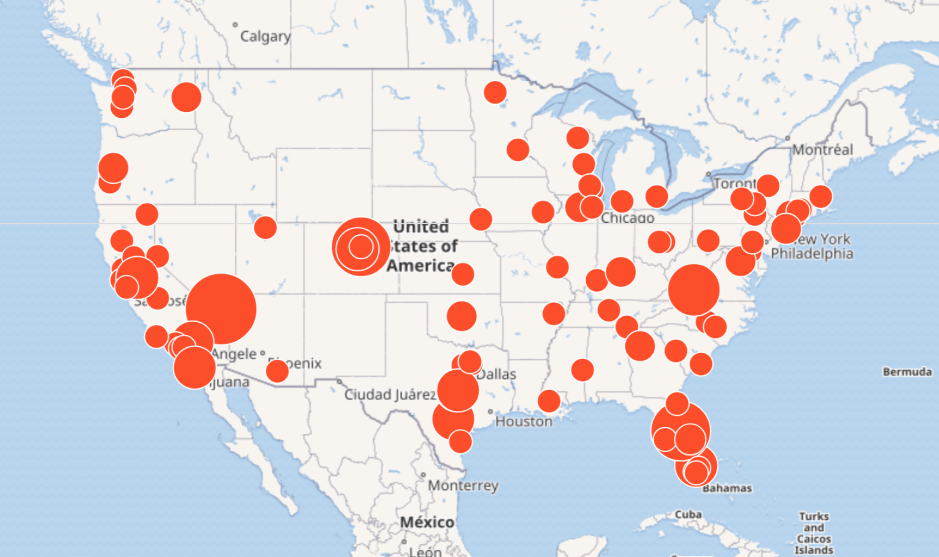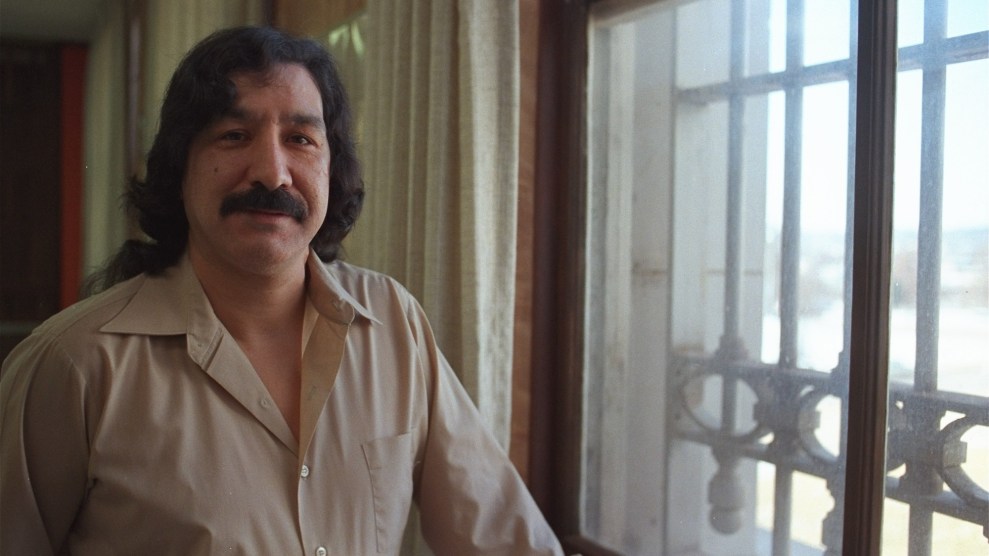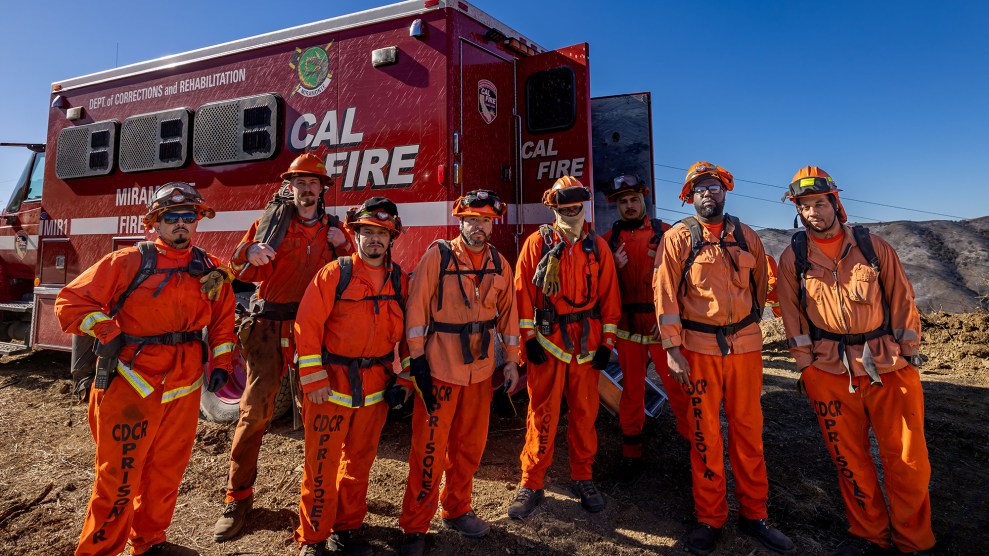Shortly before dark on the evening of April 17, 1963, Robert J. Dowlut went looking for a gun inside the city cemetery in South Bend, Indiana. Making his way through the headstones, he stopped in front of the abandoned Studebaker family mausoleum. He knelt by the front right corner of the blocky gray monument and lifted a stone from the damp ground. Then, as one of the two police detectives accompanying him later testified, the 17-year-old “used his hands and did some digging.” He unearthed a revolver and ammunition. As Dowlut would later tell a judge, the detectives then took the gun, “jammed it in my hand,” and photographed him. “They were real happy.”
Two days earlier, a woman named Anna Marie Yocum had been murdered in her South Bend home. An autopsy determined she had been shot three times, once through the chest and twice in the back, likely at close range as she’d either fled or fallen down the stairs from her apartment. Two .45-caliber bullets had pierced her heart.
Less than an hour after her body was found, two police officers had gone to Dowlut’s home and asked him to help locate Yocum’s 16-year-old daughter, whom he’d dated. After a short, fruitless search, the officers took him to police headquarters. Though Dowlut was booked as a material witness, investigators soon came to suspect that the tall, polite Army private, home on a two-week leave, had killed Yocum. After a day of intense questioning, Dowlut allegedly broke down and confessed in detail to the murder as well as to a botched robbery attempt earlier the same night in which the owner of a pawnshop was seriously wounded.

At first, Dowlut insisted that he’d thrown his gun into the St. Joseph River, but the detectives kept pushing. One officer, Dowlut later testified, “just grabbed me by the shirt, told me that I was a son of a bitch, and that I’d better show them where the gun was really at.” Not long afterward, Dowlut told his interrogators that he’d lied: “I said the gun was in the city cemetery.” According to one detective, Dowlut reeled off the weapon’s serial number from memory.
The gun Dowlut unearthed less than a half mile from the murder scene was a Webley Mark VI, a British-made six-shot military revolver commonly sold in the United States after World War II. The Indiana State Police Laboratory determined that it had fired a bullet recovered from Yocum’s body, one retrieved from her apartment, and another found at the pawnshop.
The following morning, Dowlut was charged with first-degree murder. A year and a half later, a jury found him guilty of second-degree murder. Before the judge handed down a life sentence, he asked the defendant if there was any reason why he shouldn’t be put away. Dowlut replied, “I am not guilty.” A day later, the Indiana State Prison in Michigan City registered Dowlut, now 19, as prisoner number 33848.
Less than six years later, Robert Dowlut would be a free man—his murder conviction thrown out by the Indiana Supreme Court because of a flawed police investigation. The court ordered a new trial, but one never took place. Dowlut would return to the Army and go on to earn college and law degrees. Then he would embark on a career that put him at the epicenter of the movement to transform America’s gun laws.

Today, the 68-year-old Dowlut is the general counsel of the National Rifle Association. As the NRA’s top lawyer, he has been a key architect of the gun lobby’s campaign to define the legal interpretation of the Second Amendment. He helped oversee the NRA’s effort to strike down Chicago’s handgun ban in the 2010 Supreme Court case McDonald v. Chicago, and he is the longtime secretary of the organization’s Civil Rights Defense Fund, which has spent millions assisting gun owners in court and sponsoring gun rights researchers. Dowlut’s journal articles have been cited by federal judges and are quoted by pro-gun activists. Chris W. Cox, the executive director of the NRA’s lobbying operation, has praised him as “a longtime distinguished Second Amendment scholar.” Dowlut’s behind-the-scenes legal work may have done as much to tighten the NRA’s grip on gun policy as its blustery talking heads and provocative PR campaigns.

Among Second Amendment lawyers and scholars, Dowlut is admired for his intellect and calm. “He is a really reliable and exhaustive source for legal input on the issue,” says Robert Levy, the chairman of the Cato Institute’s board of directors and one of the lawyers behind the landmark 2008 Heller case, in which the Supreme Court affirmed an individual right to own guns. Dowlut is “a human encyclopedia” on the subject of state gun laws, says David T. Hardy, a lawyer and prominent pro-gun writer who has known him “longer than I can remember.” (Dowlut and current NRA executive vice president Wayne LaPierre attended Hardy’s wedding in 1982.)
Yet Dowlut maintains an extremely low profile. “Bob is a man who does his job and doesn’t go looking for attention,” Hardy says. He rarely speaks in public and does not appear on NRA radio or video programming. While his wife, a lawyer and genealogist, maintains a website with postings on family history, gun rights, and an NRA law seminar she helped organize, Dowlut himself is conspicuously absent from those pages. He made a rare appearance on the site in a photo—removed a couple of years ago—titled “The Fantasy Supreme Court.” The group portrait shows a smiling Dowlut, his wife, and a who’s who of top Second Amendment lawyers and scholars at the NRA annual meeting in 2010. It is captioned: “These are the men who, over a span of more than 30 years, built the foundation that restored the Second Amendment as an individual right.”

The story of how Dowlut walked away from a murder conviction and rose through the ranks of the NRA has never been told publicly. It begins with the transcript of his murder trial, part of a 2,100-page court file obtained by Mother Jones that includes detailed closed-door testimony not heard by the jury. Despite a series of phone calls and detailed written requests seeking comment for this article, Dowlut did not respond, nor did his wife. It is unclear whether he has ever disclosed his past to any colleagues—Hardy told me he had “no idea” about the murder conviction—or to his employer; LaPierre and other NRA leaders also did not respond to multiple requests for comment.
Beyond the puzzle of a half-century-old crime is the question of what drove Dowlut to become one of the brains behind the modern gun rights movement, with its insistence that ready access to guns prevents, rather than provokes, violent crime. Court documents, Dowlut’s own writings, and interviews with people knowledgeable about his career offer clues to his journey. It spans from the liberated Nazi slave-labor camp where he was born and his troubled youth in Indiana to the chambers of the US Supreme Court—and the front lines of the battle over the right to bear arms.
When Officer Edward M. Scott of the South Bend Police Department pulled up at the house on West Washington Street just before 9:30 p.m. on April 15, 1963, he found an elderly woman outside, screaming, “A lady’s been shot!”

Scott and his partner entered the three-story Victorian and found a woman crumpled on the second-floor landing. “She was lying more or less on her knees in a squat position and her head was hanging down the stairway,” Scott recalled at Dowlut’s trial. “I noticed there was a large hole in her back and there was a pool of dark blood all underneath her body.” The elderly woman, who had phoned the police, lived across the hall from the victim’s small attic apartment but hadn’t seen anything.
When the victim was turned over, Scott recognized her as Anna Marie Yocum, a 36-year-old waitress and single mother. One afternoon about six months earlier, he’d escorted Yocum to the hospital to see her teenage daughter, Camille, who’d fainted at a lunch counter. The girl had been with her boyfriend, Robert Dowlut, who’d told the officer how to find Yocum.
By chance, Scott had spotted Dowlut earlier on the night of the murder. About 90 minutes before they discovered Yocum’s body, he and his partner were dispatched to help investigate the shooting of Saul Berkowitz, the 65-year-old owner of a pawnshop. As the officers stopped at an intersection, Dowlut crossed in front of their car, heading in the direction of Yocum’s apartment, two blocks away.
Dowlut was already familiar to the police. In January 1962, according to the South Bend Tribune, he had admitted to what a front-page article described as a “crime spree”: Armed with guns stolen from the local historical society’s museum, Dowlut and another teenager had robbed a café, netting about $135. Witnesses at the café said the two had brandished a pistol and a homemade zip gun, firing a shot before emptying the till. (In addition to being charged with armed robbery and burglary, Dowlut had faced counts of car theft, hit-and-run, and malicious trespass, according to a 1964 presentencing report.) Brought into juvenile court, the 16-year-old reportedly gave no explanation for his behavior and maintained that he’d never so much as broken a window previously.

After conferring in Polish with Dowlut’s parents, refugees who had immigrated after the war, Judge Frank X. Kopinski opted for lenience. “My logic tells me you should be sent away, but my heart says no,” the judge told Dowlut, according to the Tribune. Dowlut was put on probation and graduated from Washington High School in January 1963 with a good academic record. At the end of the month, he enlisted in the Army and headed off to Fort Knox, Kentucky, for basic training and a fresh start.
Corresponding with his probation officer in March 1963, the young GI sounded hopeful: He was planning to attend signal school in Georgia and perhaps try out for Airborne and a post overseas. He also indicated that he’d decided not to marry Camille, a prospect that had been weighing on him. She was pregnant but had recently said he was not the father. “I knew I would be marrying the girl from mere obligation,” he wrote in the letter, which would be read into the record at his murder trial. “I will go to college as soon as I finish my obligation to Uncle Sam,” he continued. “I will be out when I am twenty years old. I will be more mature and I will have a whole new outlook on life.”
Those plans were dashed when Officer Scott and his partner pulled up to the Dowluts’ modest home on West Dunham Street. As they drove Robert Dowlut to police headquarters, they passed by the commotion outside Yocum’s building. Dowlut asked what had happened. Nothing, Scott told him. The officer then asked Dowlut what he’d been doing earlier that night. “Well, I have a lot of problems,” he recounted Dowlut saying. The teen said he’d spent much of the evening wandering around by the river. He described the route he’d taken home, which did not include the intersection where Scott had seen him. “Robert,” Scott replied, “you lying to me.”
At the station, Dowlut was taken to an interrogation room, where a trio of detectives began questioning him. He recalled that they first asked about Yocum’s daughter and who she associated with. “They thought that perhaps she did it,” he testified. Camille reportedly arrived at her mother’s apartment two hours after the shooting and was taken into “protective custody.” The police concluded she wasn’t involved in the crime. According to the South Bend Tribune, the police also detained two other young men for questioning, but they were let go. A 38-year-old man, described during the trial as “friendly” with Yocum, was also interviewed and released.
Dowlut refused to take a polygraph, and a test for gunpowder residue on his hands proved inconclusive. Yet the police believed they had enough circumstantial evidence to keep him in custody. First, there was his apparent lie about his whereabouts. The police also had learned that Dowlut had been seeing Camille against her mother’s wishes and that he and Yocum disliked each other. There was an eyewitness report of a young man in his early 20s, approximately 6 feet tall, running near the site of the pawnshop shooting. (Dowlut was 6 feet tall.) And then there was Dowlut’s juvenile record.
Around midnight, Dowlut testified, he asked if he could call a lawyer. Inspector Russell Hunt, the lead detective, told him, “No, you can’t have one; you’re under investigation for homicide.” (Hunt testified that Dowlut never asked for a lawyer.) Dowlut said that when he asked what would happen if he tried to leave, an officer patted his holstered gun and growled, “You damned Polack, you step one foot out of that door and I’ll kill you.”

Over the following two and a half days, Dowlut was questioned for a total of nearly 20 hours by no fewer than eight police officers. During that time, he did not see a lawyer and was not charged with any crime. His statements were not recorded. At his murder trial, details of his interrogation were revealed behind closed doors by the officers who had arrested and questioned him, and by his parents and Dowlut himself. The jury did not hear these sworn statements, but Dowlut’s lawyers submitted them as part of his appeal to the Indiana Supreme Court.
While the chronologies offered by Dowlut and the police closely matched, their accounts of what was said starkly contradicted each other. According to the police, Dowlut was offered multiple chances to contact a lawyer, was treated respectfully, and volunteered his confession. In Dowlut’s version, he was repeatedly denied access to an attorney and was driven to confess by threats, relentless grilling, and classic good cop-bad cop tactics.
Dowlut’s account was corroborated by his father, who saw him twice during his detention. Donald Dowlut, who wasn’t at home when the police arrested his son, went to visit him at the station a few hours after his arrest. “When I saw him, he look tire [sic] and he look like crying…like scared,” Donald Dowlut testified in the closed-door hearing. The Dowluts began speaking in Polish, but Hunt ordered them to speak English. Donald Dowlut asked if his son needed a lawyer; the officers told him no and that his son would soon be home.
On the night of April 16, Robert Dowlut testified, “the police started getting nasty.” When police had searched the family’s house earlier that day, Donald Dowlut told them that he personally had bought a gun through the mail but had since thrown it in the river. The detectives told Dowlut that his dad might be charged as an accessory after the fact and could go to the electric chair. One officer suggested that Dowlut could avoid prosecution by pretending to be “sick in the head,” while another allegedly threatened to “punch me in the kisser.” In his testimony, Dowlut referred by name to many of the officers who questioned him—but he said he couldn’t remember which ones had physically threatened him.
According to Detective Erwin Hampton, Dowlut broke down and confessed on the afternoon of April 17:
He said that he wanted to marry his girlfriend, Cammie; he said that her mother was against this, didn’t like him, was trying to prevent them from seeing one another, and he didn’t like Mrs. Yocum. He said he was about due to go back to camp and that he wanted to take Cammie with him, but he needed some money, so he said that he took this gun from his home, and I asked him what kind and he said it was a Webley, a .45 Webley. He said that he took the gun and he stuck it in his pants, in his belt, under his jacket, and he said he went uptown looking for a place to rob.
Hampton said that Dowlut also admitted to shooting Berkowitz accidentally when the pawnshop owner grabbed Dowlut’s gun. He fled, Hampton said, stopping to vomit in the yard of “the retarded school” about a block from where Officer Scott saw him. He then walked to Yocum’s building. Hampton asked Dowlut why he went there. “I’m verbatim now,” the detective testified. “He said, ‘I went there to kill her.'”

Inside, Hampton continued, Dowlut found Yocum watching TV: “When he walked in she looked at him startled-like, and she started to get up and he fired. He went past her, she turned and went towards the door of the apartment. He was at the front end of the apartment, and he ran past her and he turned and he fired again at her, and that she fell at that time.”
Dowlut initially told Hampton that he’d thrown the gun and remaining ammunition off a bridge, but he revealed their actual location and the serial number of the gun later that afternoon. Hampton also alleged that Dowlut admitted to coaching his dad to lie about the gun when they spoke briefly in Polish at the police station. (Nowhere in the trial transcript is Donald Dowlut asked if the gun was his.) When prosecutor Edward Kalamaros asked about the gun during the closed-door hearing, Dowlut admitted that he had lied about throwing it away and that he’d told the police it was in the cemetery.
The police also tried to squeeze a written confession from Dowlut. He testified that an officer dictated a message to his family, telling him to write, “I confess my crimes.” Dowlut asked what that meant. “Well, he said, ‘You were screwin’ this girl, weren’t you?’ And I told him, ‘Yes, I was,’ and he said, ‘You screwed her more than once, didn’t you?’ and I said, ‘Yes, I did,’ and he said, ‘Well, those are your crimes, you screwed a minor girl.'” Dowlut said the police also dictated a note to Camille; in it, according to Kalamaros, Dowlut said he was “sorry for what he had done” and asked her “not to hate him.” These notes were not allowed as evidence in the trial.
In both Dowlut’s and the police’s accounts, the interrogation reached its climax when Donald Dowlut returned to the station on the evening of April 17, after the gun had been retrieved from the cemetery. Dowlut recalled, “I saw him and he saw me and I felt pretty bad about it and I started crying and told Dad that the police made me confess to something that I didn’t do.” His father described the scene similarly. He said he again asked the police to let his son see an attorney but was told, “He not need no lawyer because he confess over.”
The two police officers present also described a pathetic scene, but remembered what was said entirely differently. Edward Nawrocki, a Polish-speaking officer who knew Donald Dowlut socially, said the father and son spoke “partly [in] Polish and partly in American.” He testified that Dowlut tearfully repeated his confession to his dad. When his father asked why he’d shot Yocum, Dowlut “just kept repeatin’ that this mother was no good to her, that is, his girlfriend,” perhaps hinting at a motive beyond wanting to run away with Camille. Donald Dowlut also admitted, in tears, that he had not gotten rid of his gun, Hampton stated. “He said he was sorry for lying to me, he didn’t like to lie, but he was frightened” for his son, the detective said. Hampton also claimed that Dowlut told his dad that hiring an attorney was a waste of money because, as Dowlut put it, “I’m going to be in prison for the rest of my life.”

An attorney enlisted by Dowlut’s father arrived at the station the next morning to intervene in the interrogation. A few hours later, Dowlut was arraigned for first-degree murder. Five months shy of his 18th birthday, he was charged as an adult and bond was denied; he pleaded not guilty. Inspector Hunt boasted to reporters about cracking a case that had made front-page headlines for two days.
Dowlut was also charged with assault and battery with intent to kill in the Berkowitz shooting; he pleaded not guilty and bail was set at $100,000. Juvenile court judge Kopinski transferred the case to adult jurisdiction. “If I live to be 100 years your case will confound me,” the dismayed judge, who’d given Dowlut a break a year earlier, reportedly said. “I can’t fathom your actions, and I hope and pray that courts some day can obtain the intelligence to predict when a brilliant and talented young man like you will go awry in life.”
Dowlut’s attorney, former prosecutor William Plodowski, threw everything he could at his young, penniless client’s case. Arguing that pretrial publicity had tainted the jury pool, he got the venue changed to LaGrange County, around 50 miles from South Bend. More importantly, Plodowski insisted that Dowlut’s arrest and interrogation had violated his constitutional rights to counsel and against self-incrimination, arguing that all evidence produced from his detention should have been inadmissible.
Following the closed-door hearing on this motion, Judge Winslow Van Horne agreed that Dowlut’s warrantless arrest had been improper but did not agree that he had been coerced into confessing. However, Van Horne ruled that the police conduct plus the defendant’s youth required the court to disregard any statements obtained during his detention. As a result, the jury would not hear anything about Dowlut’s interrogation and alleged confession. Jurors would be allowed to hear about the gun Dowlut dug up—just not how the police came to locate it in the cemetery.
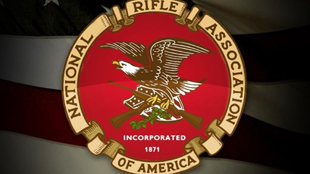
On the same day that the judge suppressed his confession, Dowlut filed a written alibi stating that he had spent all of April 15, 1963, at home, except for a short trip to a nearby store “to purchase chewing gum.” A friend of his father’s testified that he had seen Dowlut at home about a half-hour before the pawnshop robbery. Plodowski also cast doubt on the idea that his client could have committed the murder, hid the gun, and gotten home by the time the police came looking for him.
The prosecution’s case rested largely on Officer Scott’s sighting of the suspect, the trip to the cemetery, the gun and bullets, and a jailhouse informant who claimed Dowlut had admitted everything to him. Berkowitz also took the stand, describing how Dowlut had entered his store, asked to see a guitar, and then “took out his gun, put it to my stomach, and pulled the trigger.” Camille testified that a few days before her mother was shot, she saw Dowlut, who told her, “If you committed robbery in South Bend…you could get away with it.” She said that he had called her mom a “bitch” and that he wanted her to come with him when his leave ended. She said she didn’t want to, and “my mother wouldn’t have let me.”

At 1:05 a.m. on November 3, 1964, after deliberating for more than eight hours, the jury found Dowlut guilty of second-degree murder. A week later he was sentenced and put in prison. He appealed, but was denied a new trial. In early 1965, the Indiana Supreme Court agreed to review his case, and on April 1, 1968, it handed down its ruling in Dowlut v. State. The trial judge had properly rejected Dowlut’s “illegal confessions,” Justice Amos Jackson wrote on behalf of the four-justice majority, but he had improperly admitted the “poisoned fruit” of the interrogation: the gun in the graveyard.
The court reversed Dowlut’s conviction and ordered that he be retried. The decision echoed the US Supreme Court’s ruling in Miranda v. Arizona nearly two years earlier, which had affirmed criminal defendants’ right against self-incrimination during police questioning. A 1978 article in the Indiana Law Review criticized the Miranda and Dowlut rulings for invalidating otherwise reliable corroborating evidence, such as the gun in Dowlut’s trial: “The suspect’s knowledge of where the murder weapon was hidden was conclusive proof that he had knowledge of the murder.”
The state supreme court’s decision left virtually no admissible evidence, and the attempt to retry Dowlut for Yocum’s murder was eventually dropped. A week after the high court ruling, he was released into the custody of St. Joseph County, where he faced new charges for wounding Berkowitz. After two more years of venue changes and delays, the remaining charges against Dowlut were dismissed due to the state’s failure to provide a speedy trial. On April 3, 1970, Dowlut received another chance to start over. Sam Mirkin, a now-retired public defender who represented Dowlut at the end of these proceedings, recalls the day his client was released: “Mr. Dowlut said, ‘What do I do now?’ I said, ‘You call your father and have him pick you up.'”
Following his legal odyssey, Dowlut returned to the military. According to his official bio, he joined the 82nd Airborne Division, and then served with the Army Reserve’s 12th Special Forces while he attended Indiana University-South Bend. (His bio says he was honorably discharged as a staff sergeant.) Known as “Necessity U,” the small campus drew students who “likely would have had no chance for a college education,” as Dowlut’s wife, Alice Marie Beard, later recalled. Dowlut tried to recruit fellow vets to come to IUSB. As the 28-year-old told Beard for an article she wrote in the student newspaper in April 1974, “I try to impress upon them that I had been out of high school for nine years and that my parents were working-class people, but that I’m making it okay in college.”

He joined the paper’s staff and wrote a series of columns on veterans’ affairs, providing advice on everything from obtaining GI Bill benefits to removing negative or embarrassing details from discharge papers. His writing, which ran alongside columns such as “Pigs Are Pigs” (about a student’s run-in with the South Bend cops) and anti-Army ads (“Our best killers have been guys just like you” ), took a practical, even lawyerly, tone. Less than a year after he was interviewed by Beard, they married.
After graduating in 1975, Dowlut enrolled at Howard University School of Law. It was at the historically black school that Dowlut came to see gun rights as a civil rights issue, according to Robert Cottrol, a professor of law at George Washington University and a member of the Civil Rights Defense Fund board of trustees who is friends with Dowlut. He graduated in 1979 and was admitted to the DC Bar in 1980. By this time he had started working at the NRA.
Dowlut joined the organization just as it was being reborn. In what became known as the Cincinnati Revolt, hardliners had overthrown the NRA’s moderate leadership and installed Harlon Carter as executive vice president in 1977. Under Carter, the NRA adopted uncompromising rhetoric and an aggressive political strategy that turned it into one of the nation’s most powerful interest groups. Carter also envisioned recruiting “young men and women—lawyers, constitutional scholars, writers, historians, professors—who some day will be old and gray and wise, widely published and highly respected. It will be those individuals—in the future—who will provide the means to save the Second Amendment.”
Dowlut became a key player among this new generation of under-the-radar activists, doing everything from representing the plaintiff in a 1984 lawsuit challenging the nation’s first municipal handgun ban to warning housing authorities that prohibitions on tenants owning guns are unconstitutional. He has written or cowritten more than 25 amicus briefs on behalf of the NRA in state and federal cases, including a 1997 Supreme Court case aimed at striking down the Brady Law, which requires federal background checks on gun buyers. At a legal forum at the 1989 NRA convention, he warned that “the end goal of the gun prohibitionists is to ban all guns,” adding that “because of the inability of parents to instill values in youth” more restrictions were “being placed on the backs of gun owners.”
Dowlut has also helped fulfill Carter’s vision of reshaping Second Amendment jurisprudence from outside the courtroom. In the late 1970s, a small cadre of law professors and lawyers began arguing that most judges—including generations of Supreme Court justices—had gotten gun rights all wrong. In its first 200 years, the Supreme Court had considered just four Second Amendment cases; it had never affirmed an individual right to bear arms beyond the context of militia service. The only 20th-century case was in 1939, when the justices unanimously ruled against two men who claimed the federal prohibition on transporting unregistered sawed-off shotguns violated their Second Amendment rights. The new wave of pro-gun scholarship by Dowlut and his allies declared that this legal consensus was not only wrong but dangerous: The Second Amendment needed to be rescued from gun-hating judges, politicians, and activists.

Dowlut’s first articles on gun rights appeared in the early 1980s. A piece in the Oklahoma Law Review in 1983 laid out the basic premise of the modern gun rights movement: Beyond the awkward and archaic preamble about a “well-regulated militia,” the Second Amendment unequivocally secures a broad individual right to keep firearms for self-defense and “to deter governmental oppression.” As Dowlut wrote, “Draconian gun laws are an ugly form of repression often cloaked in liberal trappings.”
Dowlut’s piece was one shot in a sudden volley of pro-gun scholarship. According to an analysis by political scientist Robert J. Spitzer, between 1912 and 1969, just three law journal articles endorsed this expansive view of the Second Amendment. Between 1970 and 1989, 27 did, while 25 supported the prevalent court interpretation. By the 1990s, articles supporting the broader interpretation outnumbered those espousing the traditional view 2 to 1; 27 were written by seven authors who had worked for the NRA or other pro-gun groups, including Dowlut, who wrote three.
In 1997, Dowlut published his most forceful and sweeping article yet in the Stanford Law & Policy Review, justifying the Clinton-era militia movement and predicting that the Supreme Court would eventually strike a blow against the “bigotry, political correctness, and federal courts who give [Americans’] Second Amendment rights no respect.” That same year, ruling on the Brady Law case, Supreme Court Justice Clarence Thomas noted the “growing body of scholarly commentary” that had “marshal[ed] an impressive array of historical evidence,” and hinted at his eagerness to hear a Second Amendment case. Justice Antonin Scalia, in his 1998 book, A Matter of Interpretation, stated that “dispassionate scholarship” suggested there was a personal right to keep and bear arms. The revisionist view of the Second Amendment had gone mainstream.

Dowlut has also spent decades helping build the NRA’s Civil Rights Defense Fund (originally the Firearms Civil Rights Legal Defense Fund), a nonprofit founded in 1978 to establish legal precedents strengthening Second Amendment rights. It has recently backed cases in 35 states and Washington, DC, involving a range of issues from self-defense claims and assault weapons bans to the court-martial of a US soldier charged with murdering an Iraqi detainee. In 1996, it contributed $20,000 to the defense of Bernhard Goetz, who was sued by one of the men he had shot and wounded in the New York City subway in 1984. In 2010, the fund awarded Sen. Ted Cruz its Harlon B. Carter-George S. Knight Freedom Fund award for his work in support of Heller and McDonald as Texas’ solicitor general. Since the late 1990s, the fund has given roughly $2.5 million to pro-gun researchers; Hardy, for instance, has received at least $467,000 for various projects, including a documentary film.
Dowlut got to witness the culmination of his work on March 2, 2010. Dressed in an Airborne-maroon beret, scarf, and overcoat, he stood in the brisk darkness outside the Supreme Court as his wife handed out cookies to court watchers waiting in line. The Supreme Court was about to hear oral arguments in McDonald v. Chicago, its second gun rights case in as many years.1
Immediately after the 2008 Heller ruling, in which the court had struck down Washington, DC’s strict handgun regulations, the NRA contested Chicago’s 1982 handgun ban. The finding from Heller—that the Second Amendment protects an individual right to keep arms for self-defense—did not apply only to the capital, the NRA argued, but to the nation as a whole. Its case became part of McDonald v. Chicago, whose lead plaintiff was Otis McDonald, a retired African American maintenance engineer who had sought to buy a gun for self-defense. On June 28, 2010, the court reaffirmed its earlier ruling, 5-4. Together, these decisions emboldened the gun rights movement, setting off a surge of new challenges to local and state laws.
Writing for the majority in McDonald, Justice Samuel Alito said that the Second Amendment applied to the states, echoing an argument that Dowlut and his colleagues had been making for nearly 30 years. In their opinions, the majority cited NRA legal fund trustee Cottrol, as well as legal fund recipients Hardy and Stephen Halbrook. Though Dowlut was not mentioned by name, his influence could be seen between the lines. A popular gun rights blogger wrote, “We also should not overlook the work of NRA General Counsel himself, Bob Dowlut, whose work on this issue goes back to the ’70s.”
Dowlut has helped realize Harlon Carter’s vision of venerable scholars sitting atop an enduring legal foundation. Yet his story evokes Carter’s legacy in another way: In 1931, when Carter was 17, he was convicted of confronting, shooting, and killing a 15-year-old Mexican American boy in his hometown of Laredo, Texas. Carter’s conviction was later overturned on grounds that the judge had not adequately instructed the jury on the law of self-defense. The managing editor of the Laredo Times, which uncovered Carter’s past, noted, “When Carter applied for his job with the NRA I doubt whether he told them he had killed a man.” When the incident was reported in 1981, the then-NRA head first denied it, but came to acknowledge it. Asked about the case in 1984, Carter said, “It hasn’t hurt me with the American people. It still comes up every now and then but it will never have any effect. That was almost 53 years ago.”

It is all but impossible to know exactly what happened on that night in South Bend more than 50 years ago. The South Bend Police Department has Yocum’s murder classified as an open case. Nearly everyone involved in Robert Dowlut’s trial—the judge, lawyers, police officers, and other witnesses—is dead. Camille left South Bend; documents indicate she married the man described during the trial as having been “friendly” with her mother. He died in 1996. Reached by phone, Camille hung up when asked to comment for this story. A registered letter sent to her address was refused three times.
For now, a stack of grainy court documents contains the most detailed account of this grueling chapter of Dowlut’s life. The pages hold hints of an even more complex story, such as the moment when, according to Detective Hampton’s account of Dowlut’s interrogation, the teen turned philosophical: “He leaned back in his chair and he said, ‘Well, you know, Sergeant, it’s just like a person is two people.’ And I said, ‘What do you mean by that?’ and he said, ‘Well, if one part of me can love and the other part can kill.'”
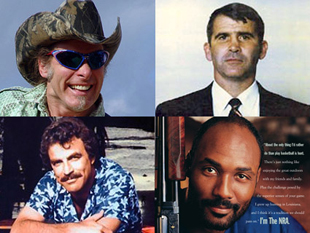
Without hearing from Dowlut himself, it’s also difficult to know exactly how his experience as a criminal defendant influenced his work. Yet it seems clear that it combined with memories of his family’s painful past to shape his views of government authority and the need to possess guns.
Dowlut’s parents grew up in eastern Poland, in what is now Belarus. During the Nazi occupation of Poland, Donald (originally named Dyonizy), Olga, and their infant son, Victor, were sent to Dachau with other non-Jewish Poles. The Dowluts were later taken to Augsburg, a slave-labor camp outside Munich that made armaments. There the baby became sick. As Alice Beard explained in an online family history, “A Nazi physician told Olga to hold her baby as Dyonizy watched. The doctor gave Victor an injection; the baby began convulsing immediately and died.”
Robert was born in Augsburg in September 1945, less than five months after the US Army liberated it and converted it to a refugee camp. He was originally named Bogdan, meaning “given by God.” In 1949, the family emigrated to Wisconsin, and then South Bend. Donald did manual labor, and Olga worked in the cafeteria at Notre Dame University. (Olga Dowlut died in 1972. Donald Dowlut died in 1989; the South Bend Tribune reported that the coroner determined that the 75-year-old had shot himself in the head.)
During the murder trial, Dowlut’s attorney drew on the family’s tragic history to undermine the police’s claims that his client had confessed voluntarily. He presented evidence that Dowlut had grown up with an intense fear of armed men in uniform due to his parents’ wartime experience. During his closed-door testimony, Dowlut said their accounts of Nazi camp guards “made me frightened of police officers.” He also said that he’d read news articles about police brutality in the United States: “Mostly they have to do with civil rights. They said that police used clubs, fire hoses, police dogs.”
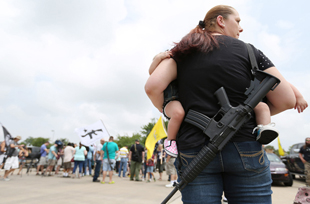
Former NRA lobbyist Richard Feldman, who first met Dowlut in the mid-’80s, says that Dowlut drew a connection between his past and his passion for the Second Amendment: “My recollection was that his parents grew up in a totalitarian society and he saw the gun as an expression of the freedom given to Americans.” This resonates with one of the key tenets of contemporary gun rights rhetoric, that the framers of the Constitution saw the right to bear arms as a bulwark against tyranny.
Dowlut’s writings also express skepticism about the government’s ability to protect citizens and their rights, including those of the accused. In his 1997 article in the Stanford Law & Policy Review, he wrote, “Historically the police have opposed any extension of constitutional rights to individuals under their control.” In his 1983 article, he cited the Supreme Court’s affirmation in Miranda of “the right to remain silent and have counsel present during a custodial interrogation.” He disapprovingly quoted Justice Byron White’s dissent, which predicted that the ruling “will return a killer, a rapist or other criminal to the streets.” 2
The Second Amendment, Dowlut has argued, must be viewed in this context. Like the criminal suspect’s right against self-incrimination, the ordinary citizen’s right to bear arms is a fundamental protection against government overreach.
Dowlut is adamant that guns do not facilitate crime or enable violent criminals. In his Stanford article, he quoted a study on gun ownership that asserted, “It perhaps goes without saying that the ‘average’ gun owner and the ‘average’ criminal are worlds apart in background, social outlooks, and economic circumstances. The idea that common, ordinary citizens are somehow transformed into potential perpetrators of criminally violent acts once they have acquired a firearm seems farfetched, most of all since there is substantial evidence that the typical gun owner is affluent, Protestant, and middle-class.”
There is a clear, bright line between law-abiding gun owners and criminals, Dowlut holds: “Those who argue that a significant share of serious violence is perpetrated by previously nonviolent ‘average Joes’ are clinging to a myth.” Only a criminal, not a gun, can turn a moment of anger or panic into a tragedy. By this reasoning, the good need never apologize—and the bad are beyond redemption.

